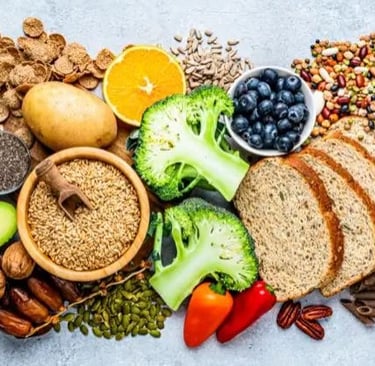Do You Know Why “Fibermaxxing” Went Viral Across Social Platforms
Fibermaxxing—maxing out your daily fiber intake—went viral in 2025. Discover why this TikTok-fueled gut-health trend took off, and how to try it safely for lasting wellness.
KNOWLEDGE & EDUCATION
Do You Know Team
8/5/20253 min read


In a world obsessed with quick-fix diets and detox trends, a surprising health movement has quietly taken center stage — Fibermaxxing. This viral trend encourages people to significantly boost their fiber intake, with promises of better digestion, more energy, weight loss, and even enhanced mood. Across TikTok, Instagram, and health forums, influencers are proudly sharing their “fiber-loaded” meals and impressive transformation stories. But what exactly is Fibermaxxing, and why has it captured so much attention?
1. The Core Idea of Fibermaxxing
“Fibermaxxing” refers to intentionally upping your fiber intake, often exceeding the usual 25–35g daily by loading meals with fiber-rich ingredients like oats, legumes, chia seeds, and vegetables. This movement reflects a shift from protein-heavy priorities toward focusing on internal wellness like gut health and longevity.
2. What the Science Says—Real Benefits
This trend isn’t empty hype. Long-term studies link elevated fiber intake to lower risks of heart disease, type 2 diabetes, colon cancer, and improved digestion. It supports balanced blood sugar, promotes healthy gut bacteria, and helps regulate mood and inflammation.
Soluble fiber slows digestion and improves blood sugar and cholesterol, while insoluble fiber supports bowel regularity—a duo essential for gut integrity.
3. Why It Went Viral in 2025
Many influencers reframed fiber as body fuel—not as boring health advice but as vibrant, visual content. Posts featured rainbow bowls packed with legumes, seeds, and leafy greens, all tagged with #fibermaxxing, now clocking over 150 million views.
The term aligns with the "bio-optimization" wave, where Gen Z is investing in sustained vitality—not quick fixes. And with up to 95% of people consuming too little fiber, the timing was perfect.
4. Risks of Going Overboard
While fiber is a hero, too much too fast can cause discomfort. Symptoms may include bloating, cramps, constipation, gas, or even nutrient malabsorption. More than 50 g per day, especially via supplements, can overwhelm your system unless paired with proper hydration.
Experts advise increasing intake gradually—about 5 g per week—while maintaining 2–2.5 liters of water per day.
5. How to Maximize Fiber—Safely and Smartly
To get fibermaxxing right:
Start slow: Add one high-fiber food per day and monitor your body’s response
Hydrate consistently: Helps fiber move smoothly through your system
Diversify sources: Mix soluble and insoluble fibers from whole foods—beans, seeds, veggies, whole grains
Use supplements sparingly: Only when needed, and preferably under guidance
Watch your body: Bloating or cramps? Dial back the pace
Consult a pro if needed: Especially if you have IBS, IBD, or medication concerns
6. Real-Life Stories & Impact
Health coaches share that fibermaxxing improved their digestion, stabilized energy, and even cleared up dull skin.
Dietitians report better blood sugar and cholesterol for clients who adopted fiber-rich meals consistently.
Everyday users express feeling lighter, less bloated, and more satisfied between meals.
These personal wins, shared in relatable short videos, fueled the trend’s spread.
FAQs
Q1: What exactly is fibermaxxing?
It’s the practice of intentionally increasing daily fiber—often beyond the usual guidelines—through whole foods like seeds, legumes, fruits, and grains.
Q2: Why is fibermaxxing trending now?
It taps into science-backed gut health, social media aesthetics, and a shift toward holistic wellness among younger generations.
Q3: What are the most essential health benefits?
Better digestion, blood sugar control, weight management, reduced inflammation, and potentially lowered risks of major chronic diseases.
Q4: What can go wrong?
Adding too much fiber too quickly can cause bloating, cramps, constipation, diarrhea, or reduce nutrient absorption—especially without enough water.
Q5: How should I start?
Increase fiber intake gradually, hydrate well, diversify food sources, track your body’s response, and consult a professional if needed.
Conclusion
Fibermaxxing isn’t just another wellness gimmick—it’s a social-media-powered return to basic, proven health habits. In an era obsessed with macros and quick fixes, this trend encourages holistic dietary upgrades rooted in gut integrity, mood, and energy. Approach it wisely, and fibermaxxing could become one of the most sustainable health habits you ever adopt.
#Fibermaxxing,#ViralTrend,#HighFiberDiet,#GutHealth,#HealthyEating,#Nutrition,#ViralHealthTrend,#DietTips
Knowledge
Empowering minds with reliable educational content daily.
Newsletter Signup
© 2025 DoYouKnow. All rights reserved.
Stay Ahead of the Trends – Join Our Newsletter
